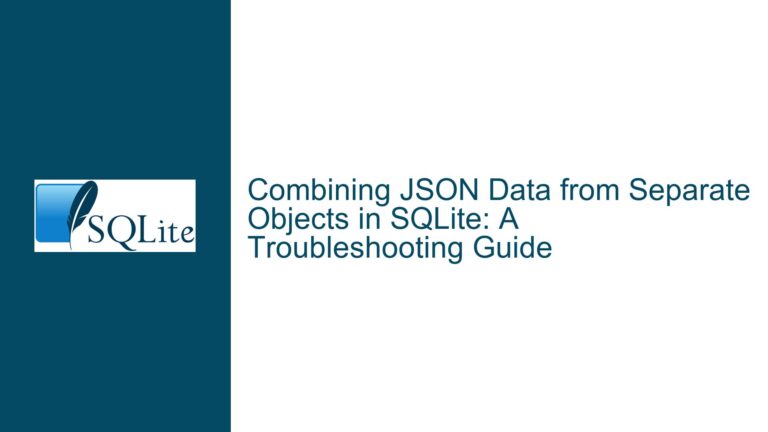DISTINCT Keyword Ignored in Initial SELECT of WITH RECURSIVE Clause in SQLite
DISTINCT Keyword Behavior in WITH RECURSIVE Queries
The issue at hand revolves around the unexpected behavior of the DISTINCT keyword when used in the initial SELECT statement of a WITH RECURSIVE Common Table Expression (CTE) in SQLite. Specifically, the DISTINCT keyword, which is intended to eliminate duplicate rows from the result set, is being ignored in this context. This behavior is inconsistent with both the SQL standard and the behavior observed in other relational database management systems (RDBMS) like PostgreSQL.
To illustrate the problem, consider a table t with columns label and step:
CREATE TABLE t (label TEXT, step INTEGER);
INSERT INTO t VALUES('a', 1);
INSERT INTO t VALUES('a', 1);
INSERT INTO t VALUES('b', 1);
The goal is to generate a sequence of rows where each distinct row from the table is copied with increasing step values. The expected output should look like this:
a|1
b|1
a|2
b|2
a|3
b|3
However, when the following query is executed:
WITH RECURSIVE cte(label, step) AS (
SELECT DISTINCT * FROM t
UNION ALL
SELECT label, step + 1 FROM cte WHERE step < 3
) SELECT * FROM cte;
The result includes duplicate rows, indicating that the DISTINCT keyword is not being honored:
a|1
a|1
b|1
a|2
a|2
b|2
a|3
a|3
b|3
This behavior is unexpected and can lead to incorrect results if not properly understood and addressed.
Interplay Between DISTINCT and Recursive CTE Execution
The root cause of this issue lies in how SQLite handles the execution of recursive CTEs, particularly in the context of the DISTINCT keyword. In SQLite, the initial SELECT statement in a WITH RECURSIVE CTE is executed only once, and its result set is used as the starting point for the recursive part of the query. The DISTINCT keyword is intended to eliminate duplicates from the result set, but in this case, it appears to be ignored.
One possible explanation for this behavior is that SQLite’s query optimizer may be treating the DISTINCT keyword differently when it is used in the initial SELECT of a recursive CTE. The optimizer might be prioritizing the recursive nature of the query over the deduplication that DISTINCT is supposed to enforce. This could be due to an oversight in the implementation or a deliberate design choice to optimize performance, though the latter seems less likely given the inconsistency with the SQL standard.
Another factor to consider is the interaction between the DISTINCT keyword and the UNION ALL operator used in the recursive part of the CTE. The UNION ALL operator does not eliminate duplicates, which means that any duplicates introduced in the initial SELECT will propagate through the recursive steps. If the DISTINCT keyword is not applied correctly in the initial SELECT, these duplicates will persist in the final result set.
It’s also worth noting that this behavior is not consistent across all RDBMS. For example, PostgreSQL correctly applies the DISTINCT keyword in the initial SELECT of a recursive CTE, resulting in the expected output. This discrepancy highlights a potential area for improvement in SQLite’s implementation of recursive CTEs.
Implementing Workarounds and Ensuring Correct Results
While the unexpected behavior of the DISTINCT keyword in the initial SELECT of a recursive CTE can be problematic, there are several workarounds that can be employed to achieve the desired results. These workarounds involve modifying the query to ensure that duplicates are eliminated before the recursive part of the CTE is executed.
One effective workaround is to use a GROUP BY clause in place of the DISTINCT keyword. The GROUP BY clause can be used to achieve the same deduplication effect as DISTINCT, and it appears to work correctly in this context. For example:
WITH RECURSIVE cte(label, step) AS (
SELECT label, step FROM t GROUP BY label, step
UNION ALL
SELECT label, step + 1 FROM cte WHERE step < 3
) SELECT * FROM cte;
This query produces the expected output without duplicates:
a|1
b|1
a|2
b|2
a|3
b|3
Another approach is to use a subquery with the DISTINCT keyword. By wrapping the initial SELECT in a subquery, the DISTINCT keyword is applied correctly, and the resulting set is used as the starting point for the recursive part of the CTE. For example:
WITH RECURSIVE cte(label, step) AS (
SELECT * FROM (SELECT DISTINCT * FROM t)
UNION ALL
SELECT label, step + 1 FROM cte WHERE step < 3
) SELECT * FROM cte;
This query also produces the correct output:
a|1
b|1
a|2
b|2
a|3
b|3
Additionally, defining a view that encapsulates the DISTINCT selection can be a clean and reusable solution. By creating a view that selects distinct rows from the table, the recursive CTE can then reference this view to ensure that duplicates are eliminated before the recursion begins. For example:
CREATE VIEW t_distinct AS SELECT DISTINCT * FROM t;
WITH RECURSIVE cte(label, step) AS (
SELECT * FROM t_distinct
UNION ALL
SELECT label, step + 1 FROM cte WHERE step < 3
) SELECT * FROM cte;
This approach not only solves the immediate problem but also promotes code reuse and maintainability.
In conclusion, while the unexpected behavior of the DISTINCT keyword in the initial SELECT of a recursive CTE in SQLite can be frustrating, there are several effective workarounds available. By using GROUP BY, subqueries, or views, it is possible to ensure that duplicates are eliminated and the correct results are achieved. Furthermore, this issue highlights the importance of understanding the nuances of SQLite’s implementation and being aware of potential differences with other RDBMS. As always, thorough testing and validation are essential when working with complex SQL queries to ensure that the desired results are obtained.






